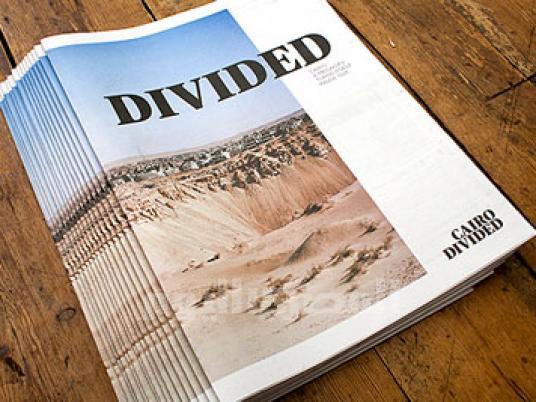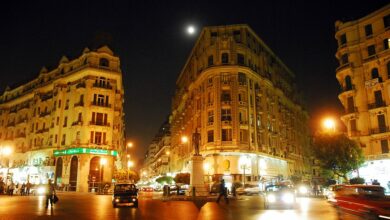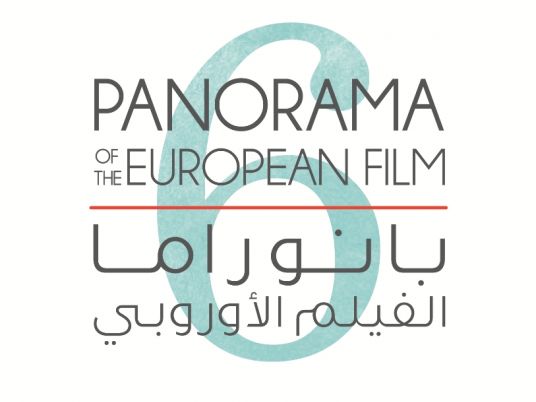
The Contemporary Image Collective downtown space was close to bursting on Wednesday night. Visitors packed into the gallery’s meeting space for a discussion on the changing urban fabric of Cairo — in particular, the desert developments popping up around the city’s periphery. The topic was clearly of great interest to the downtown crowd, as heated conversation spanning a range of issues surrounding the nature of the ever-changing mega-metropolis of Cairo carried on for nearly three hours.
The event was organized to launch a self-produced, self-financed publication called “Cairo Divided,” put together by Jason Larkin, a photographer formerly based in Cairo and now based between South Africa and London, and journalist Jack Shenker, a correspondent for The Guardian who divides his time between Cairo and London.
“Cairo Divided,” printed in color on newsprint, consists of a long-form essay by Shenker in English with an Arabic translation, and some thirty exquisite photographs by Larkin depicting the desert developments amid a desolate, moon-like landscape of eternal, feverish construction, with fields of unfinished houses, looming walls at every turn, billboards yet to hold their advertisements, and dust-covered workers slaving in the heat at an absurd and futile project never to be completed.
Shenker’s poetic essay echoes this dystopic depiction. In the concluding paragraphs, he writes, “I was struck by the casual neglect of the space around me; the bleakness of the building sites, the craters rupturing the street, the careless depositing of a future planet’s bowels.”
The image painted by Shenker and Larkin contrasts dramatically with the quiet, clean and affluent life envisioned by those who develop or strive to live in such settlements.
Shenker encapsulates this vision in the showroom of real estate developer Emaar Misr: “… recorded birdsong was being pumped out of hidden speakers, canvas awnings were dimpled with soft spot-lit purples and blues, and potential customers were moving past a series of glass portals, each featuring a different item — a plastic tea set, a pair of football boots, a laptop and calculator.”
With names like Beverly Hills, Dreamland and Utopia, these desert escapes clearly boast a fantastical promise. But Larkin’s images do not venture into the well-irrigated dream world, focusing rather on the vast spaces in between, highlighting the isolation and disconnection of the settlements, and the rubble and waste that surrounds them.
The photographs work in tandem with Shenker’s essay, the product of a close collaboration between writer and photographer. Shenker told Egypt Independent, “We always work together, whether I am just reporting, or he is just shooting. Even if I am interviewing someone in a dark room where no photographs can be taken, Jason is there too.”
“Cairo Divided” came out of several years of collaborative work on the subject of satellite cities, and abridged versions of the project have been published in various magazines. But Larkin and Shenker were frustrated by the lack of options for publishing a more complete version of their work, and decided to take matters into their own hands, sidestepping the difficult terrain of a struggling publishing industry. As Shenker told Egypt Independent, “Most publications do not have the budget or the space for long-form essays.” In a way, their piece interrogates the limitations of mainstream journalism and proposes a different production possibility for those working in the field.
The two produced “Cairo Divided” with support from the photography agency Panos Pictures, which, inspired by the project, has plans to make a series of such productions. While Larkin and Shenker have yet to work out effective distribution in Cairo, they have sent the publication out to university departments in Egypt, the United States and England, and even a stack to Occupy Wall Street, targeting communities with an interest in urban issues.
Shenker and Larkin do not hide their bias against the desert compounds: “Cairo Divided” does not tell every side of the story, does not get into possible solutions, and only touches on the root causes and motivations of those who make the decision to retreat to the desert. It serves as a kind of introduction to the phenomenon of satellite cities as they have risen out of the policies of the Mubarak era, and a vivid evocation of the mark they are making on the greater Cairo landscape. The publication reiterates how this urban expansion is a face of mushrooming neoliberal policies, but doesn't spend as much time unpacking the moment when this expansion gained momentum in Cairo and explaining what this momentum says about residents' perceptions of their city.
Shenker writes, “The advance of private capital is marshaled by an aggressively retreating state, gated compounds for the elites are reimagined as inclusive national projects, isolation gets marketed as community and plush green golf courses can rise miraculously from some of the most arid land on earth,” describing in strong words the frustrating inequality exemplified by developments like Beverly Hills and Katameya Heights.
At the Wednesday night discussion, Shenker introduced “Cairo Divided” by bringing up a range of issues that his essay touches on. Panelists including writer Ursula Lindsey, Mohamed Elshahed, a PhD candidate at New York University who blogs on urban issues at the Cairo Observer, Wafaa Nadim, a lecturer at the British University in Egypt, and architect Ahmed Zaazaa responded to Shenker’s propositions, and posed questions of their own. The resulting conversation gave rise to a great amount of hostility toward the satellite city phenomenon, and a sense of frustration as to the breadth of problems facing Cairo. It also highlighted the challenges of such a broad discussion within a limited group of people, as it was pointed out that actual satellite city dwellers were almost non-existent among those at the event, making the question of their motivations difficult to address.
Nonetheless, the meeting facilitated an outpouring of ideas and opinions. Shenker told Egypt Independent that he hoped “Cairo Divided” would act as a touchstone for conversation, raising questions and sparking discussion. On Wednesday evening that that is exactly what the publication did.
All available copies of “Cairo Divided” were snatched up Wednesday evening, and more can be procured in PDF form by contacting the authors through the project website, http://www.markdearman.com/cairodivided, or CIC at [email protected].




